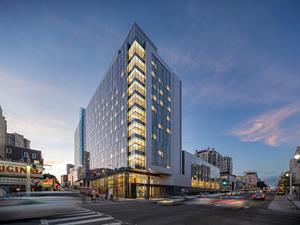SAN FRANCISCO, March 01, 2019 (GLOBE NEWSWIRE) -- Today SmithGroup celebrates the opening of the new Sutter Health California Pacific Medical Center (CPMC) Van Ness Campus Hospital in downtown San Francisco, California. Tomorrow, the 1,015,000-square-foot, $2.1 billion hospital will welcome its first patients.
|
||||||||
Envisioned as a new hub for Sutter CPMC services citywide and based on a strategic master plan developed by SmithGroup, the flagship hospital brings adult acute care and women’s and children’s care into one state-of-the-art facility. Eleven patient floors house 274 beds in an environment designed to provide patients an empowering, calming and healing experience.
“The new Van Ness Campus hospital embodies what the urban hospital of the future should be,” says Heather Chung, strategic medical planner for the project and a vice president at SmithGroup. “As the flagship facility for CPMC, it serves as the beacon for health in the city and exemplifies Sutter’s goal of connecting and integrating healthcare with the community.”
SmithGroup led the planning and design of the new hospital, delivered through an Integrated Project Delivery (IPD) process in collaboration with contractor HerreroBOLDT and 16 other risk-reward partners. Among the largest IPD hospital projects completed in the United States, the cohesive design and construction approach resulted in numerous successes including delivering the project on time and $150 million under the original project budget.
Sitting atop the peak of Cathedral Hill at the busy intersection of Van Ness Avenue and Geary Boulevard, the new 12-story building enhances the urban fabric with a contemporary glass, metal and stone tower meant to reflect the high-rise commercial and residential buildings of the city’s nearby Financial District.
“Because it is a monumental building occupying an entire city block, we sought design solutions that respond to the scale and texture of its downtown San Francisco context,” explains Kent Hetherwick, project manager for the Van Ness Campus hospital and a principal at SmithGroup. “The tower has slightly convex geometry to visually reduce its bulk, kinked slightly outward mid-block. A dichroic fin articulates the kink on either side of the tower and adds colorful flair to the distinctive pattern of the glass curtainwall.”
At street-level, shadow boxes with colored LED lighting and varied glass, green walls and micro-retail storefronts soften the building. Widened sidewalks, abundant bench seating and planters that both treat stormwater and buffer the sidewalk from the street create a safer, more enjoyable experience for pedestrians.
Inside the hospital, each floor is themed to a natural element—earth, flora, water, light and air—with sophisticated finishes, colors and the use of super graphics to reinforce the concept of that floor and help to orient visitors. Lighting design throughout the hospital enhances healing and helps to clarify wayfinding in the large facility.
In response to California’s 2030 deadline that hospitals must be capable of remaining operational after an earthquake, the building uses two novel approaches to strengthen the structure against seismic vibration. One-hundred-twenty viscous wall dampers are placed around the perimeter of the building’s floorplates to absorb vibration, the first time this technology has been used in a hospital in North America. Four-sided structural silicone sealant on the glass curtainwall system provides a higher-performance façade in a seismic event.
The new hospital is designed to use 14% less energy than an average hospital of its size and is targeting LEED Silver certification from the United States Green Building Council (USGBC). One-hundred-percent of patient rooms receive direct natural daylight, and energy-efficient LED lighting is used where artificial light is needed. A 100-percent filtered outside air system enhances the interior air quality while being a lower-energy ventilation system. Five vegetated roofs totaling 25,000 square feet are planted with native plants that filter rainwater for irrigation, saving 180,000 gallons of drinkable water annually.
SmithGroup's San Francisco office provided integrated design services including strategic master planning, architectural design, medical planning and programming, interior design and lighting design. Other members of the Integrated Project Delivery Team are HerreroBOLDT, a joint venture of Herrero Builders (San Francisco) and The Boldt Company (San Francisco), as construction manager and general contractor.
Other design IPDT team members include Ted Jacob Engineering Group (Oakland, CA) as mechanical engineer, Degenkolb Engineers (San Francisco) as structural engineer, CallisonRTKL Associates (San Francisco) as medical equipment consultant, Silverman and Light (Emeryville, CA) as electrical engineer and Vantage Technology Consulting (San Francisco) as technology consultant.
SmithGroup (www.smithgroup.com) is one of the world’s preeminent integrated design firms. Working across a network of 13 offices in the U.S. and China, a team of 1,300 experts is committed to excellence in strategy, design and delivery. The firm partners with forward-looking clients to maximize opportunities, minimize risk and solve their most complex problems. SmithGroup creates exceptional design solutions for healthcare, science and technology organizations, higher education and cultural institutions, urban environments, diverse workplaces, mixed-use and waterfront developments, and parks and open spaces.
Attachments
Christa Montgomery SmithGroup 202.974.0798 christa.montgomery@smithgroup.com
